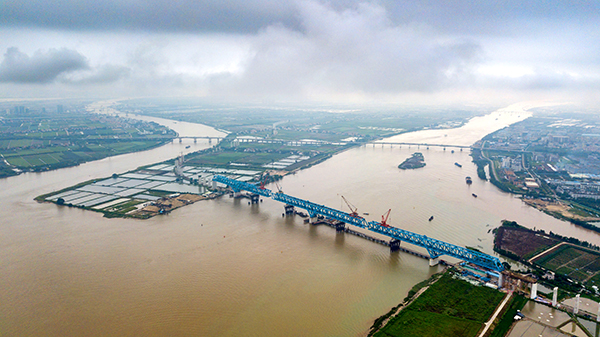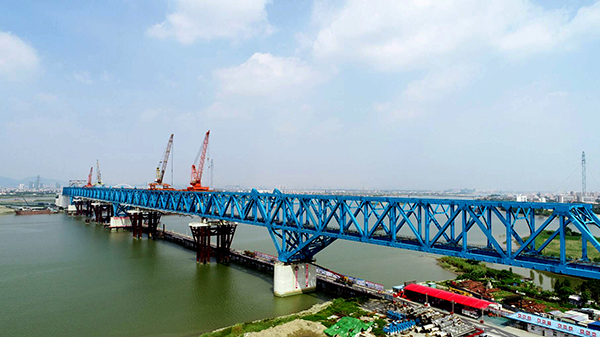World's Longest-spanned Flexible Continuous Truss Arch Bridge Completed
The steel truss of the Hongqili Grand Bridge of Nansha Port railway was completed on Aug 25, with a maximum span of the steel truss flexible arch bridge of 360 meters.
Designed by China Railway Siyuan Survey and Design Group Co., Ltd., the bridge is an arch bridge with flexible continuous truss structure and has the longest span in the world.
The total length of the bridge is 998 meters and a total of 28,000 tons of steel was used during the construction.
The flexural rigidity of the steel truss is 80 times that of a flexible truss, which improves the bridge's carrying capacity. The distance from the arch rib to the water surface is more than 100 meters, which equals the height of a 33-storey building.
Nansha Port railway — a major transportation infrastructure in the Guangdong-Hong Kong-Macao Greater Bay Area — is currently the only railroad under construction in the China (Guangdong) Pilot Free Trade Zone Nansha Area of Guangzhou.
The railway is about 87.79 kilometers long and has a designed speed of 120 kilometers per hour. It is expected to be completed in 2020.
Dubbed "a museum of long-span and complicated railway bridges", the Nansha Port railway includes the Xijiang cable-stayed bridge with a 600-meter span, a 175-meter main span parallel chord steel truss-structured highway and a railway dual-use bridge over Jiya water channel, as well as a 448-meter main span cable-stayed bridge over Longxue South waterway and a 230-meter span tied-arch bridge on Xiaolan waterway and the 2x360-meter span Hongqili bridge.
Nonstop container trains from Nansha Port to European countries will be put into service when the railway opens to traffic.
The completion of the bridge's steel truss is significant to the open of the railway and will contribute to construction of the Guangdong-Hong Kong-Macao Greater Bay Area.

The steel truss of the Hongqili Grand Bridge of Nansha Port railway is completed on Aug 25. [Photo/sasac.gov.cn]

The steel truss of the Hongqili Grand Bridge of Nansha Port railway is completed on Aug 25. [Photo/sasac.gov.cn]
(Executive editor: Zhang Tianyuan)



